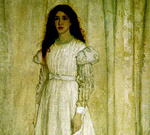James McNeill Whistler
Matthew Dennison expolres the career of Whistler at a new exhibition of his etchings at the Fine Art Society


It must have seemed to James McNeill Whistler, in December 1880, that the odds stacked against him were overwhelming. His successful libel case against Ruskin who famously accused him of 'flinging a pot of paint in the public's face' had yielded damages of a farthing and ruinous legal costs. Declared bankrupt in May 1879, the Europhile American artist had accepted a commission from the fledgling Fine Art Society (FAS) in London's New Bond Street, and headed for Venice with his advance.
In Venice, Whistler created a body of work that, on his return, was presented in three one-man shows at the FAS. The first of 12 etchings of Venice opened on December 1, 1880. Despite considerable press attention, sales were poor and the gallery called it a commercial failure. Undeterred, it unveiled 'Venice Pastels' the following month. In his copy of the exhibition catalogue, E. W. Godwin, Whistler's friend and architect of the house in Tite Street that bankruptcy had forced Whistler to sell, singled out for particular comment a single painting, Bead Stringers. He described it as 'sunny and jewelly'. An etching of the same subject had been among the poor sellers of the previous exhibition.
From October 14 to November 8, that etching will again hang at the FAS, one of 30 such works spanning three decades. Whether the etching, like the pastel, strikes today's viewer as 'sunny and jewelly' is probably a matter of taste. Whistler began etching in his twenties. He was initially spurred on by his brother-in-law, Francis Seymour Haden, an English surgeon and gifted amateur etcher. Among the artist's earliest subjects was Haden's daughter, Annie. His portrait of Annie her unsmiling face the apex of a pyramid of unwieldy garments is among the exhibits.
That the image survives suggests that not only were Annie's parents pleased with it, but so was Whistler himself. At this point, newly arrived in London from Paris and sensing already his distance from the mainstream British arts establishment a gulf that would broaden over time Whistler recognised etching as his surest way of making a positive impression on the city's art scene. He decided to publish a series of etchings, and embarked on a walking and working tour through France, Luxembourg and the Rhineland, to create additional images that were shortly afterwards published as 'Twelve Etchings from Nature'. The year after, he worked closer to home, creating a series of Thames etchings. Three were accepted for the RA's Summer Exhibition of 1860, and Whistler's relationship with the British arts hierarchy had begun its tumultuous course.
The present exhibition includes both French and Thames subjects. Although all show the germ of Whistler's future artistic development, they also demonstrate that, at this early stage in his career, his concern with artistic form expressed through tonal oppositions and juxtapositions of light and shade took a notably more conventional form than would later be the case. In images such as The Kitchen, we see Rembrandt's influence.
Seymour Haden owned a collection of Rembrandt prints, and Whistler visited Holland in 1863, and throughout the 1880s. It was only in 1889, however, that he created the 11 intricately wrought etchings known as the 'Amsterdam Set', which are the crowning achievement of his print-making career. Closely and densely worked, they balance bold contrasts of light and dark with soft sfumato passages and explorations of the play of light on water. In making these works, which include The Embroidered Curtain, the delicacy of his line quickly blunted under the printing process. Whistler abandoned the plates after printing only 30 impressions of each thus his images of Amsterdam are works not only of rare beauty, but beautiful rarity.
'James McNeill Whistler: The Embroidered Curtain' is at The Fine Art Society, 148, New Bond Street, London W1 until November 8 (www.faslondon.com)
Exquisite houses, the beauty of Nature, and how to get the most from your life, straight to your inbox.
Country Life is unlike any other magazine: the only glossy weekly on the newsstand and the only magazine that has been guest-edited by His Majesty The King not once, but twice. It is a celebration of modern rural life and all its diverse joys and pleasures — that was first published in Queen Victoria's Diamond Jubilee year. Our eclectic mixture of witty and informative content — from the most up-to-date property news and commentary and a coveted glimpse inside some of the UK's best houses and gardens, to gardening, the arts and interior design, written by experts in their field — still cannot be found in print or online, anywhere else.
